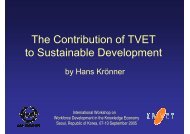Learning for Life, Work and the Future Initial ... - Unesco-Unevoc
Learning for Life, Work and the Future Initial ... - Unesco-Unevoc
Learning for Life, Work and the Future Initial ... - Unesco-Unevoc
Create successful ePaper yourself
Turn your PDF publications into a flip-book with our unique Google optimized e-Paper software.
Page 76 Participants’ Papers <strong>Learning</strong> <strong>for</strong> <strong>Life</strong>, <strong>Work</strong> <strong>and</strong> <strong>the</strong> <strong>Future</strong><br />
VET per<strong>for</strong>mance is <strong>the</strong>re<strong>for</strong>e rated as successful if it<br />
is capable of ensuring relevance <strong>and</strong> expected quality,<br />
accessibility, af<strong>for</strong>dability <strong>and</strong> sustainability, <strong>and</strong> is<br />
both externally <strong>and</strong> internally efficient <strong>and</strong> effective.<br />
Why VET Re<strong>for</strong>ms?<br />
Originally VET was supply-driven, government-controlled<br />
<strong>and</strong> financed, <strong>and</strong> was based on knowledge.<br />
This system fitted well with <strong>the</strong> planned economy:<br />
inadequate links between training <strong>and</strong> <strong>the</strong> real world of<br />
work were not an issue, <strong>and</strong> graduates readily found<br />
employment in <strong>the</strong> labour-intensive public sector.<br />
The VET operational context had to change with <strong>the</strong><br />
adoption of a dem<strong>and</strong>-driven market economy whose<br />
users bear <strong>the</strong> costs <strong>and</strong> manage <strong>the</strong> operations. The<br />
importance of linking training to <strong>the</strong> world of work<br />
could not be over-emphasized.<br />
Several reviews of <strong>the</strong> original VET <strong>the</strong>re<strong>for</strong>e led to<br />
<strong>the</strong> 1994 VET Act, whose key features are that VET<br />
should be:<br />
• Dem<strong>and</strong>-driven, to service both <strong>for</strong>mal <strong>and</strong> in<strong>for</strong>mal<br />
dem<strong>and</strong>s (being accessible to different target<br />
groups)<br />
• User-controlled, <strong>and</strong> managed through a tripartite<br />
Board<br />
• User-financed through a VET levy of 2% of <strong>the</strong><br />
payroll<br />
• Decentralized<br />
• Co-ordinated <strong>and</strong> directly supervised through an<br />
autonomous body, to ensure quality of delivery.<br />
The establishment of a Vocational Education <strong>and</strong><br />
Training Authority (VETA) in 1994, <strong>and</strong> <strong>the</strong> subsequent<br />
adoption of a new Vocational Education <strong>and</strong><br />
Training System are <strong>the</strong>re<strong>for</strong>e <strong>the</strong> result of changes in<br />
<strong>the</strong> socio-economic environment of Tanzania that<br />
necessitated <strong>the</strong> corresponding adaptation of VET.<br />
To date, VETA has made significant strides in trans<strong>for</strong>ming<br />
<strong>the</strong> original supply-oriented VET system into<br />
a dem<strong>and</strong>-driven VET system.<br />
The New VET System’s Focus Is on Providing<br />
• Flexibility in mode of delivery in terms of duration,<br />
entry qualifications, <strong>and</strong> exit to <strong>the</strong> labour market<br />
• Close alignment with job dem<strong>and</strong>s in both self- <strong>and</strong><br />
wage employment so as to address skills requirements<br />
in <strong>the</strong> two areas<br />
• Integration of business <strong>and</strong> entrepreneurial skills to<br />
meet <strong>the</strong> needs of real work situations, <strong>and</strong> translation<br />
of vocational skills into business <strong>and</strong> enterprises<br />
• Integration into <strong>the</strong> country’s social <strong>and</strong> economic<br />
policies <strong>and</strong> plans so as to ensure accessibility to<br />
different target groups.<br />
2. The Competence-Based Education <strong>and</strong> Training<br />
(CBET) Concept<br />
The move from traditional VET has been made possible<br />
following <strong>the</strong> adoption of <strong>the</strong> Competence-Based<br />
Education <strong>and</strong> Training (CBET) concept by <strong>the</strong> VET<br />
Board in December 1998. This concept enhances<br />
effectiveness <strong>and</strong> efficiency of VET through a comprehensive<br />
approach that enables training to be adapted to<br />
suit <strong>the</strong> needs of <strong>the</strong> workplace, allowing <strong>for</strong> <strong>the</strong> application<br />
of technical skills in business, <strong>the</strong>reby ensuring<br />
that <strong>the</strong>y are appropriately market-oriented.<br />
• Modularised training that allows <strong>the</strong> trainee to<br />
choose specific individual training units according<br />
to <strong>the</strong> skills needed <strong>for</strong> employment, or to go <strong>for</strong> <strong>the</strong><br />
full cycle of units. In <strong>the</strong> first case, <strong>the</strong> successful<br />
completion of each unit is certified separately;<br />
in <strong>the</strong> second case, trainees receive <strong>the</strong> full trade<br />
recognition after completion of all <strong>the</strong> required<br />
training units. Within this process <strong>the</strong> existing<br />
<strong>for</strong>mal training curricula are being modularised.<br />
• Non-<strong>for</strong>mal training in which <strong>the</strong> training packages<br />
are specifically designed <strong>for</strong> selected target groups,<br />
ei<strong>the</strong>r by using existing training units of <strong>the</strong> curriculum<br />
or by developing tailor-made training programmes.<br />
The timing of non-<strong>for</strong>mal training is<br />
adapted to fit into <strong>the</strong> trainee’s commitments as a<br />
business operator or employee.<br />
The concept covers a number of trades in regular<br />
dem<strong>and</strong>, with predetermined competencies recognised<br />
by <strong>the</strong> employers <strong>and</strong> <strong>the</strong> training providers. It integrates<br />
technical <strong>and</strong> critical cross-cutting skills to<br />
produce a complete worker who fits into a customeroriented<br />
economy.<br />
As distinct from <strong>the</strong> traditional knowledge-based VET,<br />
CBET hinges on <strong>the</strong> following key features:<br />
• Training <strong>and</strong> assessment of outcomes are based on<br />
st<strong>and</strong>ards.<br />
• Training st<strong>and</strong>ards are derived from an analysis of<br />
occupational tasks to <strong>for</strong>m a DACUM Chart of<br />
employment requirements.<br />
• The analysis of occupational tasks pays particular<br />
attention to <strong>the</strong> expected per<strong>for</strong>mance criteria.<br />
• Competent persons who are well acquainted with a<br />
given job carry out this analysis, involving external<br />
expertise.<br />
• Be<strong>for</strong>e use, st<strong>and</strong>ards are approved by Trade<br />
Advisory Committees.





